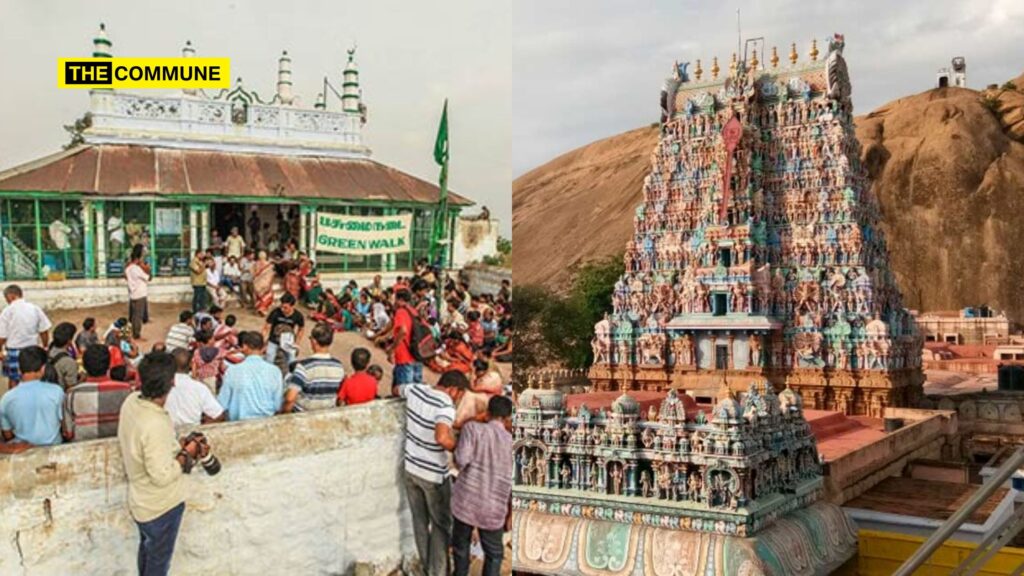Madurai’s Thirupparankundram Hill, home to the ancient Murugan Temple, has long been at the center of a legal and religious dispute. The recent protests owing to the encroachments by the Islamists and desecration acts by their ilk beg us to take a look at the landmark ruling in 1931 by the Privy Council in London. This ruling settled the question of ownership, affirming the temple’s rights over the hill while allowing a mosque to remain in its specific location.
It was the Privy Council in London which ruled in favour of the claim of the temple to the sacred Tirupparankundram Hill by quoting the historical documents of the temple, including that from ASI. It observed
“There seems to be no suggestion that the Tirupparankundram temple or… pic.twitter.com/kGwE4gUovx
— 𑀓𑀺𑀭𑀼𑀱𑁆𑀡𑀷𑁆 🇮🇳 (@tskrishnan) February 5, 2025
What Are The Origins Of The Dispute?
The legal battle over Thirupparankundram Hill involved three main claims:
- The Temple’s Claim: The temple administration asserted ownership over almost the entire hill, except for a few cultivated lands and the mosque’s site.
- The Muslim Claim: Muslim petitioners claimed the area where their mosque stood, and an additional portion of the hill called Nellitope.
- The British Government’s Claim: The colonial administration argued that all unoccupied land on the hill belonged to the government, as it was considered “waste land.”
The 1923 Court Ruling
The case was first heard in a Madurai court in 1923, which ruled mostly in favor of the temple. The court recognized that the temple had exercised control over the hill for centuries and officially granted it ownership of the land. However, it made two exceptions:
- The mosque’s site, its flagpole, and its access steps.
- The Nellitope area, which was allocated to the Muslim claimants.
The British government’s claim was entirely rejected.
The 1926 Madras High Court Appeal
The Muslim claimants appealed this ruling to the Madras High Court in 1926. However, instead of clarifying Hindu or Muslim rights over the land, the High Court took a different stance—it declared that the entire hill belonged to the government, dismissing the temple’s claim.
The Final Ruling: Privy Council Decision (1931)
The temple authorities challenged this decision in the Privy Council, the highest legal authority under British rule. After reviewing historical records, the council issued a landmark ruling in 1931, restoring the temple’s ownership rights. The key points of the ruling were:
- The temple had existed for centuries, likely since the 13th century or earlier.
- The entire hill was considered sacred and had been referred to in official documents as “Swamimalai” (God’s Hill).
- The temple had exercised ownership for over 100 years, maintaining temple roads, repairing structures, and managing the land.
- No historical evidence suggested that Muslim rulers had ever taken over the hill or disrupted temple activities.
- The British government’s claim to “waste land” was invalid, as the land was in active use by the temple.
Final Verdict
The Privy Council overturned the Madras High Court ruling and reinstated the 1923 decision. It confirmed that:
- The Murugan Temple legally owned Thirupparankundram Hill, except for the mosque’s designated area and the Nellitope land.
- The mosque could continue to exist in its specific location, but the broader hill remained under temple control.
This ruling continues to be significant, as it established clear ownership rights over Thirupparankundram Hill. Any further disputes over the land must take this historic judgment into account.
(With inputs from The Hindu)
Subscribe to our channels on Telegram, WhatsApp, and Instagram and get the best stories of the day delivered to you personally.

